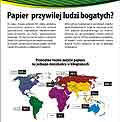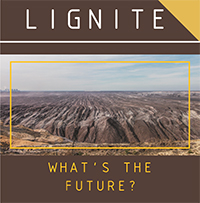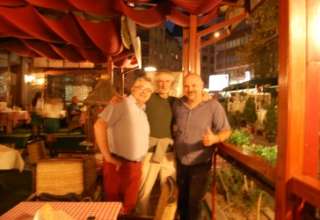
The Exhibition “Paper – a global product” was created in December of 2005 by three organizations: Ecological Company “Eko-Unia,” ROBIN WOOD, and the Federation of Green Gaja. The breadth of the exhibition, presented in general to the teachers of elementary schools and beyond, was modeled in part after a German exhibition founded under partnership with Initiative 2000. The part ended up being altered to fit Polish parameters.
The exhibition consists of six tables, each representing an aspect of the problems associated with the production of paper.
The first table shows statistics about paper consumption around the world and in Poland – it turns out that 20% of the world’s population consumes up to 80% of the production of paper. We also presented, with considerable difficulty, data on recovery of waste paper in Poland.
The second table indicates the dramatic overall consequences of the partially illegal logging of forests throughout the world, for example of the moist coniferous forests of Canada. In this table we presented briefly the importance of forests to maintain biodiversity. Also we reminded that the destruction of forests is done mostly without paying mind to the violation of land rights of indigenous people. Forests play big role in society, which cannot be reduced to the price of wood as it is also a source of cultural and spiritual wealth.
The third table we named “ecological balance” contains data on the costs of production of paper from wood (fresh fibers) and recycled paper. The numbers are clear – recycled paper is cheaper and represents a significant reduction in hazardous waste. Collecting and processing waste paper has nothing to do with idealism detached from reality, which is an accusation towards environmental organizations.
Another table highlights one of the important aspects of paper production: cellulose. An intermediate product between wood and paper, cellulose must be bleached chemically. Bleaching is done with or without the use of chlorine. The former, more harmful to the environment, still is used in Third World countries, where environmental protection has not yet become a priority states. In countries in the European Union, less harmful bleaching methods are more common.
The fifth table shows that the collection of waste paper is not a foreign activity in Poland. To our delight, the model of waste paper collection also is spread through ecological education of children in schools, where projects related to forest management are carried out.
The last table shows both foundations of Initiative 2000 plus, as well as the history of our project “Bet on waste paper – school notebooks can protect the forests.” They, in short, demonstrate the benefits of using school supplies, especially notebooks, from recycled paper.
In comparison with the German exhibition, the Polish version was weaker in the table showing marking of paper – ie. trade marks indicating the origin of the paper and its whitening. In Poland, these markings are not registered and there is a large amount of freedom given to manufacturers. Unfortunately, in general there is no information on the origin of raw materials and the type of whitening.
The ceremonial opening of the exhibition took place on May 10th 2006 in the Primary School 93 in Wroclaw, ul. Niemcewicza.






